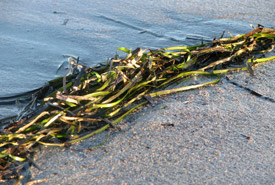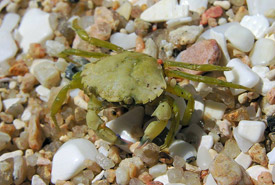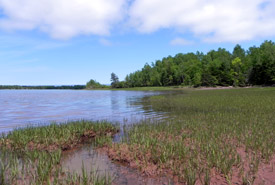Eel-grass: A moment in time

Eel-grass, Port Joli, Nova Scotia (Photo by NCC)
As we bushwhack through dense alder thickets, we hear the drone of a small plane flying back and forth over the Pugwash Estuary. It is a perfect summer day in August with a clear blue sky, perfect for capturing aerial imagery of Pugwash. The moment has finally arrived after months of research and planning; we’re finally getting the imagery necessary to create a baseline dataset of eel-grass in the estuary.
Important aquatic habitat
Eel-grass is a type of flowering submerged aquatic vegetation (also known as seaweed) that is found in coastal environments around the world and is one of the most productive ecosystems in the world. Their slippery, grass-like leaves can form dense meadows, providing numerous benefits to coastal environments. When healthy, eel-grass forms dense underwater meadows that provide structured habitat for a number of species on what would otherwise be open, shifting sands. These meadows act as a nursery area by providing food and protection for many commercial fish species as well as other sea creatures like shrimp and lobsters.
But it’s not just fish and crustaceans that benefit from eel-grass. Waterfowl such as Canada geese rely on eel-grass as an important food source during migration and overwintering.
Grasses under pressure
Eel-grass meadows are crucial parts of the coastal ecosystems in Atlantic Canada, but they are under pressure. It’s no surprise that increased coastal development can put stress on these meadows through pollution, dredging, boat traffic and nitrogen inputs from upstream sources. It’s not just humans who can impact eelgrass meadows. A marine slime mold also known as "wasting disease" can cause a huge decline in eel-grass meadows, just like it did in the 1930s here in Atlantic Canada.

Juvenile European green crab (Photo by Luis Miguel Bugallo Sanchez)
The newest threat though comes in the form of a small, rather self-absorbed, crab called the European green crab. This species native to Europe and North Africa arrived on the shores of Atlantic Canada in the 1990s. Since then it has spread from Newfoundland to Virginia, competing for resources and significantly affecting the abundance of eel-grass in coastal areas.
The interesting point is that the green crab is not known for eating the eel-grass. Instead, as the green crabs dig in the sandy or muddy bottom looking for prey, they loosen the roots or clip off shoots of eel-grass. Although one or two green crabs might not be able to disrupt an entire eel-grass meadow, but green crabs can reach maximum abundance in these areas — meaning there could be hundreds, if not thousands, of them in an estuary.
So what are we doing to help?
Because there are so many threats to these important areas, the Nature Conservancy of Canada (NCC) is trying to do what it can to protect them.

The Pugwash Estuary is a unique mixture of forest, marsh and sandy beaches (Photo by NCC)
In conservation planning, the first step to complete is to gather background information on the area of interest. In Atlantic Canada, few areas have good information on the abundance of eel-grass.
Although we know eel-grass is known to be found in the Pugwash Estuary, to date no one has looked at the extent of the eel-grass meadows. With help from the local environmental group Friends of the Pugwash Estuary and photographer Mike Dembeck, we set out this August to start gathering this data.
Using a plane to gather aerial imagery of the estuary at low tide and some on-the-ground data collection, we hope to create a good baseline of what the eel-grass meadows are like in 2014. These results will help inform management decisions in the area and provide a reference for research questions in the future.
Analyzing all of the data can take some time, but stay tuned for the results!


